Level of Foxp3, DNMTs, methylation of Foxp3 promoter region, and CD4 + CD25 + CD127low regulatory T cells in vulvar lichen sclerosus
- PMID: 33438816
- PMCID: PMC11896417
- DOI: 10.1002/kjm2.12356
Level of Foxp3, DNMTs, methylation of Foxp3 promoter region, and CD4 + CD25 + CD127low regulatory T cells in vulvar lichen sclerosus
Abstract
This study is to investigate the pathogenesis of vulvar lichen sclerosus (VLS) by analyzing the level of Foxp3, DNMTs, methylation of Foxp3 promoter region, and CD4 + CD25 + CD127low Regulatory T cells (Tregs). This study enrolled 15 VLS patients and 25 controls. Lesional and extralesional vulvar skin tissues, normal vulvar skin tissues and peripheral blood were collected. Compared with the control group, Foxp3 protein in the lesional and extralesional skin of VLS group was significantly reduced. The levels of DNMT1 and DNMT3b proteins in lesional skin of VLS group were significantly increased. There was no difference in the total methylation rates of the promoter region of the Foxp3 gene. The methylation rates of CpG1, CpG4, CpG9, and CpG10 were significantly higher in lesional skin of VLS group than in control group. There was no correlation between the total methylation rates of 10 CpG sites and the level of Foxp3 and DNMT1 proteins; there was a positive correlation between Foxp3 and DNMT1 protein in lesional skin of VLS group (r = 0.675, p < 0.05), and a negative correlation (r = -0.665, p < 0.05) in extralesional skin of VLS group. However, there was no correlation of Foxp3 with DNMT3b. The number of CD4 + CD25 + CD127low Tregs VLS decreased significantly. The expression of Foxp3 protein and the quantity of CD4 + CD25 + CD127low Tregs in patients with VLS decreased, which may cause local or systemic abnormal immunosuppression of Tregs, leading to the occurrence of VLS. This may be related with methylation or DNMT1, which needs further verification.
Keywords: CD127; CD4 + CD25+ Treg; Foxp3; methylation; vulvar lichen sclerosus.
© 2021 The Authors. The Kaohsiung Journal of Medical Sciences published by John Wiley & Sons Australia on behalf of Kaohsiung Medical University.
Conflict of interest statement
All authors declare no conflict of interest.
Figures



Similar articles
-
[Studies about the level of CD4+ CD25+ regulatory T cells and relation between expression of Foxp3 and CD127 in peripheral blood of chronic HBV infection].Zhonghua Shi Yan He Lin Chuang Bing Du Xue Za Zhi. 2010 Feb;24(1):21-3. Zhonghua Shi Yan He Lin Chuang Bing Du Xue Za Zhi. 2010. PMID: 20848841 Chinese.
-
CD4(+)CD25(+)CD127(-) and CD4(+)CD25(+)Foxp3(+) Regulatory T Cell Subsets in Mediating Autoimmune Reactivity in Systemic Lupus Erythematosus Patients.Arch Immunol Ther Exp (Warsz). 2016 Oct;64(5):399-407. doi: 10.1007/s00005-016-0399-5. Epub 2016 May 7. Arch Immunol Ther Exp (Warsz). 2016. PMID: 27156107 Free PMC article.
-
Reduced frequency and functional defects of CD4+CD25highCD127low/- regulatory T cells in patients with unexplained recurrent spontaneous abortion.Reprod Biol Endocrinol. 2020 Jun 10;18(1):62. doi: 10.1186/s12958-020-00619-7. Reprod Biol Endocrinol. 2020. PMID: 32522204 Free PMC article.
-
Non-small-cell lung cancer-induced immunosuppression by increased human regulatory T cells via Foxp3 promoter demethylation.Cancer Immunol Immunother. 2016 May;65(5):587-99. doi: 10.1007/s00262-016-1825-6. Epub 2016 Mar 21. Cancer Immunol Immunother. 2016. PMID: 27000869 Free PMC article.
-
Epigenetic mechanisms of regulation of Foxp3 expression.Blood. 2009 Oct 29;114(18):3727-35. doi: 10.1182/blood-2009-05-219584. Epub 2009 Jul 29. Blood. 2009. PMID: 19641188 Free PMC article. Review.
Cited by
-
Advances in the pathogenesis of vulvar lichen sclerosus.Mol Biol Rep. 2024 Mar 7;51(1):396. doi: 10.1007/s11033-024-09318-7. Mol Biol Rep. 2024. PMID: 38453810 Review.
-
Trends and Developments in Vulvar Lichen Sclerosus Research.Health Sci Rep. 2025 Jul 9;8(7):e71007. doi: 10.1002/hsr2.71007. eCollection 2025 Jul. Health Sci Rep. 2025. PMID: 40636539 Free PMC article.
-
Sex-related Variations in Comorbidities in Lichen Sclerosus: A Systematic Review and Meta-Analysis.Acta Derm Venereol. 2024 Aug 7;104:adv39982. doi: 10.2340/actadv.v104.39982. Acta Derm Venereol. 2024. PMID: 39113339 Free PMC article.
-
Lichen sclerosus: The 2023 update.Front Med (Lausanne). 2023 Feb 16;10:1106318. doi: 10.3389/fmed.2023.1106318. eCollection 2023. Front Med (Lausanne). 2023. PMID: 36873861 Free PMC article. Review.
-
Vulvar Lichen Sclerosus from Pathophysiology to Therapeutic Approaches: Evidence and Prospects.Biomedicines. 2021 Aug 3;9(8):950. doi: 10.3390/biomedicines9080950. Biomedicines. 2021. PMID: 34440154 Free PMC article. Review.
References
-
- Lee A, Fischer G. Diagnosis and treatment of vulvar lichen Sclerosus: an update for dermatologists. Am J Clin Dermatol. 2018;19(5):695–706. - PubMed
-
- Yang M, Wen W, Chang J. Vulvar lichen sclerosus: A single‐center retrospective study in China. J Dermatol. 2018;45(9):1101–1104. - PubMed
-
- Cooper SM, Ali I, Baldo M, Wojnarowska F. The association of lichen sclerosus and erosive lichen planus of the vulva with autoimmune disease: A case‐control study. Arch Dermatol. 2008;144(11):1432–1435. - PubMed
MeSH terms
Substances
Grants and funding
LinkOut - more resources
Full Text Sources
Other Literature Sources
Research Materials

